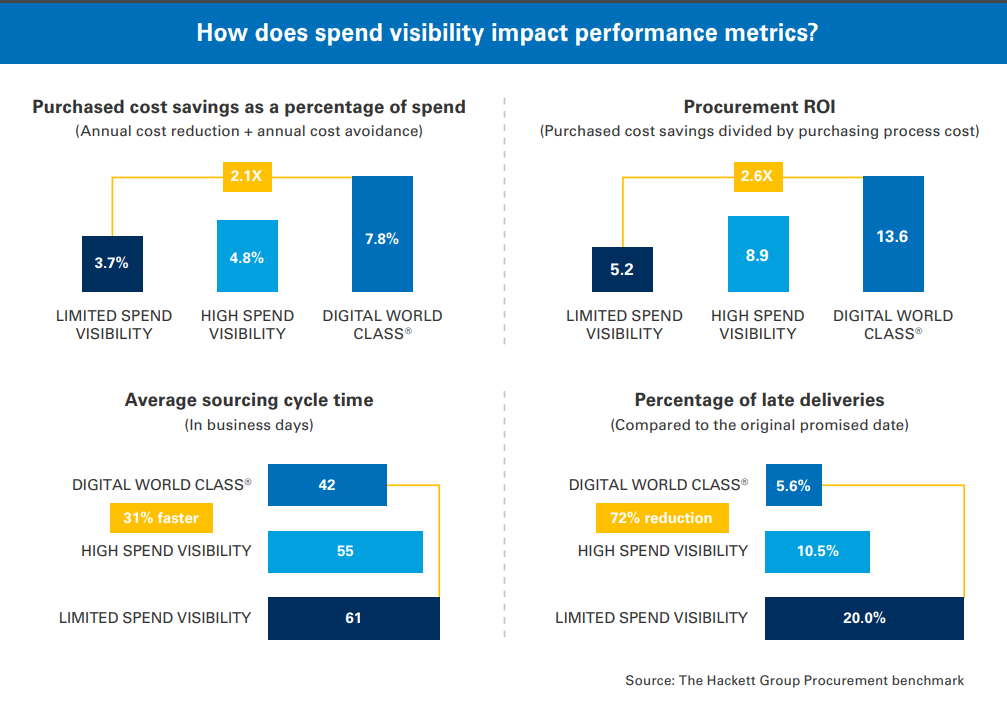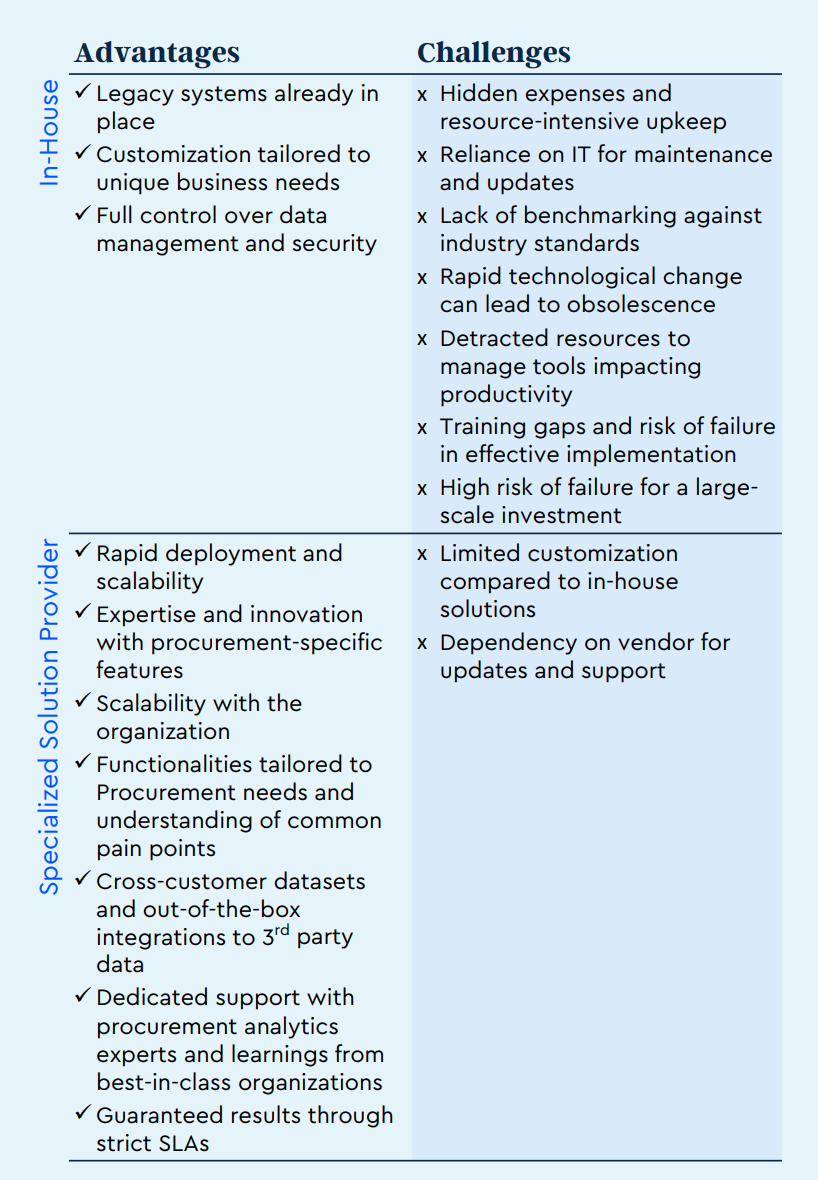Every procurement organization needs visibility of their spend. There are many ways to do this. For some, a simple Excel-based desktop exercise suffices, while others might need sophisticated analysis solutions to cater to large enterprises.
Procurement data can be dirty, scattered and require plenty of attention. However, it can be extremely valuable when properly managed. In this article, we will go through how to best use the data in your hands.
Why You Need a Spend Analysis Solution
Traditionally, purchasing data was seen as a byproduct of buying activities - it had no perceived value.
Today, procurement data has been identified as an important business asset. Yet, relatively few organizations embrace it to gain a competitive advantage.
Benefits of Spend Analysis
- Understand past performance to guide future decisions.
- Use trends to predict future business performance.
- Support budgeting and management with data-driven insights.
The information gained from analyzing data is used to guide procurement category strategies, strategic sourcing projects, contract management and optimize the entire source-to-pay cycle. In addition to management insight, with data analysis companies have realized multi-million dollar savings opportunities. To be specific, we've found companies waste $15-55M on every $500M of spend every year because of missed opportunities.
According to The Hackett Group, when looking for advanced spend analytics solutions, 56% turn to point solutions like Sievo. DIGITAL WORLD CLASS® organizations leveraged spend visibility for 2.6X Procurement ROI, 31% faster cycle times, and a 72% reduction in late deliveries.

Organizations have come to realize that they need a procurement data strategy - and either make sense of the data themselves or partner up with a supplier that knows how to deal with their data.
Defining a Data Strategy
Before diving into data, you must define your data strategy based on your specific business challenges.
Start by mapping all relevant data sources, such as:
- Invoice data
- Contracts
- Supplier master data
- P-card transactions
Creating a clear plan will provide direction on how you collect, cleanse, store, manage and share the information for maximum benefit and profitability. Unstructured and unused data becomes an asset when it is combined, classified, and analyzed.
Given the dynamic nature of procurement, a data strategy is not static and should evolve over time.
Learn how MediaMarktSaturn turned their scattered data into 90% faster spend analysis
Why Excel is Not Enough for Spend Analysis
Data analysis can be done as a spreadsheet exercise in Excel. Excel is a great tool for building dashboards that can provide analysis and deliver timely insights. While doing spend analysis in Excel is doable, most people will fail to do it efficiently and encounter issues. As your organization grows, so does the complexity of your data, making Excel unscalable.
Key Limitations of Excel
- Not scalable for millions of rows of data
- High risk of data inconsistencies
- Time-consuming manual updates and classifications
- Formatting issues
Even if you’re successful doing all this, it can take hours or even days of work. The same “update and classify” data crunching exercise is repeated each month, which will not be scalable without purpose-built tools for doing so.
According to Deloitte’s CPO Surveys (2020 & 2021), high-performing organizations invest in advanced analytics, predictive capabilities, and AI to maintain a competitive edge. Investing in specialized tools becomes essential as data complexity increases.

Build vs. Buy: Making the Right Choice
Before considering how to build or buy a procurement data solution you need to understand:
- What data do you have, and what is its quality?
- Where is your data stored, and how is it accessed?
- How is your data currently managed and governed?
- What level of customization does your solution require?
- Is there a solution available in the market that can fulfill those needs?
The decision of whether to develop an in-house IT solution (build) or source a solution externally (buy) is a never-ending debate. Assuming there is already an appetite at senior level for a solution, there are three main issues to consider:
Total Cost of Ownership (TCO)
Since procurement’s top priority is making savings, cost must be high on the agenda. The total cost of a proposed solution over its entire life cycle must be the basis for the calculation. Procurement teams apply Total-Cost-of-Ownership (TCO) principles to all key make-vs-buy projects, this is no different.
Read an in-depth analysis of the TCO of Spend Analytics software
Most buy applications need integration with existing infrastructure and internal systems. When calculating the time expected to complete the entire project, specific time-consuming activities such as customization, changing work processes and retraining staff need to be costed and added.
Building a system internally means an IT team needs to use a platform such as Microsoft Power BI and continue to maintain it. The build cost includes technical training (if required) and direct labor costs but should exclude any fixed costs.
The duration of an in-house built project is often longer due to the pressure of other IT priorities. Time is money and delays are expensive. Should your TCO calculation stand for the “build” option, it makes sense to double-check if all related costs are taken into account and if the quality of in-house development and monthly upkeep is comparable to external solutions.
See below exemplary TCO comparison over a 3-year period.

Overall, the cost of the ”buy” should be less than the ”build”. This is due to vendors being able to utilize economies of scale and specialization, leading to lower unit costs. The attraction is often the offered subscription pricing model avoiding an upfront expense. The key here is to select and pay for only the functionality you need.
Criticality
How important is having an effective procurement data management system to the success of your business? The answer is very. Without usable historical spend data decision-making on future procurement is guesswork.
System downtime is a risk, can an in-house system or external service provider guarantee that the system will be 99% available? Your stakeholders are likely very eager to make the most out of the vast mass of procurement data they have at hand, which means there is an urgency element involved.
Whether build or buy, the solution selected must meet all your specified criteria and be both secure and legally compliant.
Availability of Skills
The choice of buy or build must consider how much technical skill and capacity is available internally and how mature the IT function is.
Learn how to collaborate better with IT w/ Full eBook: Procurement <3 Data
In addition to technical skill, specific competence related to the procurement landscape is required to understand how data can be best used as internal customers might face a challenge getting across what they really need and what is possible solution-wise.
Any skills upgrade project takes time and investment. Potential vendors of procurement analytics solutions are likely to have the knowledge and expertise available but are they relevant to your industry or business sector? Check for relevant customer testimonials and market reviews.
Here, we've provided a summary of all the pitfalls of in-house solutions, when compared with specialized solution providers like Sievo:

To learn more, read our full guide to compare Sievo and in-house procurement analytics tools!
Presenting the Business Case
Presenting the facts to senior management relating to cost, criticality, and availability of skills are not the only considerations. The political and cultural environment within the organization has an influence.
Organizational maturity in terms of data utilization plays its own part. There are known and unknown biases at play that influence the decision-making process. Prior experiences with a vendor, aggressive marketing by vendors, and end-user preferences all play a part.
Maintenance & Support Considerations
Whichever route is chosen the system will require security patches, bugs fixed, and new features added. An in-house build will depend on the development capabilities and capacity of existing IT staff, assuming that they are fully acquainted with market developments in procurement technologies.
The in-house team should understand how to classify and draw conclusions from the procurement data that best serve the end user requirements.
Without that expertise, troubleshooting will have to rely on external community support. It could be said that an internal team has more control over planning changes and upgrades, thereby building confidence with stakeholders.
Vendors have extensive technical analytics expertise and support teams for their products - this is built into the price. A robust service level agreement (SLA) can ensure the quality of implementation, maintenance, and support – this applies equally to both build and buy solutions.
Final Thoughts
Technology alone will not deliver the results you are looking for. It is a tool that, in the right packaging with the right handling, can provide an easy-to-use-and-maintain system that delivers procurement value.
The solution to the question - Buy or Build - may be a hybrid. There is no definitive answer. Buying a cloud-based software solution that is flexible, agile, and secure that can be integrated into your current platform can make sense on your data roadmap as your organizational maturity increases.
Imperfect data can be valuable for dynamic procurement needs and can be enriched and combined with external data. Working with external partners can provide access to unique data streams and insights.
It does not out-scope the possibility to add in-house developed modules as your needs demand and vary over time.
At the end of the day, only no-value data is data that is not utilized. Your procurement data strategy and chosen solution are as unique as your business.
Key Takeaways for Procurement Data Success
- Be reasonable in defining the scope of the project. Define what must be included now and create a road map of future additional features.
- Secure an executive sponsor and confirm the budget.
- Secure an IT sponsor to support technical requirements.
- Communicate the plan to stakeholders and end-users to ensure engagement and alignment with their needs.
- Establish metrics to track its success.
- Invest in change management to get the most out of your new system.
Photos:
Yulia Matvienko @yuliamatvienko (picture 1)






